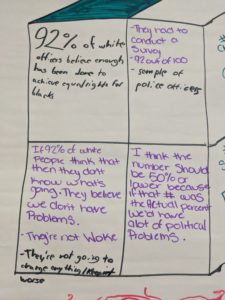“Whoever designed Pokemon Go is pretty smart.” This thought as I was standing in my socks throwing imaginary Pokeballs at this Charmander that was virtually standing in my parents yard. The technology was impressive, but what impressed me the most was how they made the game so darn playable. The only Pokemon knowledge I have is from overhearing student conversations, I don’t have any games installed on my phone and would not have heard about this game if it weren’t on the evening news (and everywhere else). If Niantic, the creators of the game, can get a mobile game recluse to spend their vacation trying to catch imaginary “Pocket Monsters” in order to reach level 16, they must be doing something good. After playing pretty consistently for the last 3 weeks, I found plenty of connections to teaching which are worth sharing here.
Wait, what does this have to do with teaching?
First, why is it so relevant to teaching. Pokemon, and the Pokemon universe is a rich established body of knowledge. There are books of Pokemon knowledge, published well before this game came out, that contain relevant information for any player. For Niantic to achieve mainstream success they needed to break this information down in a way that someone new to this world could slowly pick up, while also not boring experienced knowledgeable players. Don’t forget, they also had ensure understanding of the complicated nature of the game itself, whose mechanics and relationships are also things needing mastery. Niantic had to do a lot of teaching in order to get people in to this game.
Immediate immersion, immediate success
The teaching for this game gets started very quickly. After you install the app, before you even decide your username, the first thing the game has you do is go out and capture Pokemon. Before you know if the introduction has finished, you are out of your seat. In my case I was out of the front of my parents’ house. The task was very intuitive. By following the map a short distance and clicking the Pokemon that appeared on the screen I was all ready participating in authentic game play. I immediately learned to flick the Pokeballs at the creature to capture it and saw the animation which confirms that it has been added to my collection. The little Charmander that I captured was actually a real thing, and the process I followed in capturing it was one that I would repeat over and over again. By immediately giving players a real experience, and one that ensured immediate success, it created confidence and a desire for more.
It left me thinking, “How quickly can I get my class into a math task?” Do we have to get the seating chart figured out, hand out books, and talk about the cell phone policy? Maybe the icebreaker can be built into a group task and they can learn names along the way? Why not take Pokemon Go’s lead and throw students into an activity that is actually related to the content that they will be learning. Have them follow the processes for reflection that they will repeat over and over like using their math journals or engaging in a group conversation afterwards. The administrivia can get covered next class, or next week, and instead engage the kids in an interesting math task right from the start.
Low-entry, high-ceiling gaming
The big news stories about Pokemon go describe hordes of people in public areas going after certain characters. It’s quite amazing that Niantic was able to create a game that so many people can be engaged in. There is effort required to play Pokemon Go, but not much. Two days after signing up I joined my mom on her morning walk around the neighborhood. The goal was to catch up with my mom, and also catch some Pokemon. The effort required to play the game was the same that my 73 year-old mother puts forth before her morning tea. Because of that, there is a very low barrier to entry for this game.
Once you’ve started there are things you can also do but they are different for each player. The app will vibrate your phone when a Pokemon is close enough to catch. On that walk it showed me a low-strength Pokemon that is easy to catch. If I clicked on it today, the game would show a Pokemon of the same species but one with higher strength that is harder to catch because now I have leveled up 16 times. The game makes the Pokemon capture experience seem the same despite being of different challenge for players at different levels. Similarly, if two players get supplies from a Pokestop, the game gives more valuable supplies to the more experienced player. The game builds in differentiation so that players of all ability can walk along together. Because of this, the game has a very high ceiling for participants to be able to play and be challenged.
Facilitate teamwork
After playing the game for a few days everyone playing must join a team. These teams really come in to play when players want to try to attack these gyms, something that I was never really successful with. For people who want to be victorious in these virtual Pokemon battle grounds it is directly beneficial to work with your team. When I first had one of my Pokemon in the gym, I could see the icons of other people’s Pokemon who were fighting along with me.
Protecting a gym requires contributions of multiple players. If you win a gym, the game lets anyone assign their Pokemon to the gym to defend it. Players can only put in one of their creatures, which forces cooperation. The strongest player can’t put all of their strongest Pokemon to protect the gym, they need contributions from other members of his team if they are going to be successful. Like with good group work activities, it’s a situation where everyone is able to contribute, and benefit.
Balancing highlighting progress and not over-sharing
Less than a month after it’s release, scores of fans threatened to quit the game forever. The reason? Niantic temporarily shut down the feature allowing players to track how close they were to nearby Pokemon. Players were ready to give up because of the lack of information about their progress when Pokemon searching. Then I wondered if students check out of my class because they similarly don’t see how they are progressing.
Niantic’s decision came from the desire to shut down 3rd-Party websites who used that tracking system to find Pokemon. These apps showed where certain creatures are likely to spawn and appealed to people who didn’t want to find out the hard way. Niantic was worried that their tracking system was giving too much away to the players, and preventing them from learning about the Pokemon themselves. It is one of the few non-classroom example of the struggle between giving feedback and giving away too much information.
Targeted, instructional, real-time feedback
One afternoon I decided to battle at a Pokemon Gym that I found across the street from my school. These battles are interesting examples of how real time feedback helps you learn. Firstly, you can find see your character or the opponent lose strength as you attack, as do most games. The game will also tell you whether the attack was “Super effective” or “Not effective”. You learn quickly to swap your ineffective Pokemon with one of the other ones that you have captured in order to finish the battle. Effectiveness is determined by a ridiculously complicated set of relationships between individual Pokemon of certain types. No amateur player is going to sit down and memorize or even consult these giant charts before killing some time on their phone. The timely feedback about the battle, that comes at the right time serves to instruct the person with enough information about this larger set of relationships to finish the battle. If a Pokemon you’re using is flawed, you know to replace it, if it is Strong, you can remember to use it for next time. It’s a nice recipe for giving students some feedback as they are working on a task. Just point out what they are doing that is effective, or maybe ineffective. When you catch your self giving them the information outside of the whole task, back away and let them figure out those larger relationships on their own.
Time Management
I learned a lot of things from Pokemon Go. Now that summer is ending and I have to get busy planning other things, I don’t have time to keep trying to “Catch ’em All” so I had to uninstall the app. This probably the most valuable lesson that I got from the game, your time is too valuable to waste.

